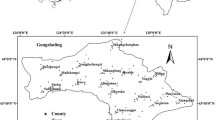Abstract
The aim of this study was to determine the ecological safety of reclaimed lands from subsided areas that had been filled with mining wastes and fly ash for agricultural purposes in the Liuxin mining area, Xuzhou, China. Both chemometric techniques and geostatistics were utilized to test the concentrations of As, Hg, Pb, Cu, Cd, Cr and Zn in reclaimed soils and in control soil at different depths. Results showed that, relative to local soil background values, the degree of variation in Hg, Cu, Cd and Pb at the majority of sampling points was large, especially for Cu in the control soil, Zn in the gangue site was also high, while As and Cr concentrations in the fly ash site and control soil were low. With reference to the China soil quality standard, besides Cd and a few samples of As, Zn and Cu, the other heavy metal concentrations were all lower than the standard. Based on this, the seriously high Cd levels were studied. To describe the regularity of the change in Cd concentration with depth, the polynomial fitting model was adopted and was found to be feasible. To achieve quantitative analysis from qualitative description, the Kriging interpolation model was applied to investigate the regular distribution of Cd. This model proved to have high precision at the fly ash site.






Similar content being viewed by others
References
Boularbah A, Schwartz C, Bitton G, Morel JL (2006) Heavy metal contamination from mining sites in South Morocco: 1. Use of a biotest to assess metal toxicity of tailings and soils; 2. Assessment of metal accumulation and toxicity in plants. Chemosphere 63(5):802–817
Facchinelli A, Sacchi E, Mallen L (2001) Multivariate statistical and GIS-based approach to identify heavy metal sources in soils. Environ Pollut 114:313–324
Haberlandt U (2007) Geostatistical interpolation of hourly precipitation from rain gauges and radar for a large-scale extreme rainfall event. J Hydrol 332(1–2):144–157
Hu ZQ, Qie JZ et al (2002) Physical and chemical properties of reclaimed soil filled with fly ash. J China Coal Soc 27(6):640–643
Huang CY, Long J, Teng Y et al (2002) Characteristics of soil microbes of reclaimed minesoil in red Soil area, southern China. J Soil Water Conserv 16(2):126–129
Huang Y, Guo QR, Ren H, Wan HF (2004) Application and perspective of geostatistics in the study on soil heavy metals. Ecol Environ Sci 13(4):681–684
Kuperman RG, Carreiro MM (1997) Soil heavy metal concentrations, microbial biomass and enzyme activities in a contaminated grassland ecosystem. Soil Biol Biochem 29:179–190
Li R (2008) Spatial variation and the characteristics of accumulation and transfer of heavy metal pollution about soil-crop systems in typical area. A thesis submitted to Nanjing Agricultural University
Li Y, Shi Z, Xu JM, Huang MX (2003) Utilization and perspective of geostatistics in soil sciences. J Soil Water Conserv 01:178–182
Lin YP (2002) Multivariate geostatistical methods to identify and map spatial variations of soil heavy metals. Environ Geol 42:1–10
Liu XX, Wang CH, Liao CL, Li HB (2007) The research on the methods of heavy metal spacial variation in soil. Agric Netw Inf 6:106–108
Tan WN et al (2005) The application of geostatistics to soil science. Trop Geogr 04:307–311
Tsai LJ, Yu KC, Chang JS, Ho ST (1998) Fractionation of heavy metals in sediment cores from the Ell-Ren River, Taiwan. Water Sci Technol 37:217–224
Van Groenigen JW, Pieters G, Stein A (2000) Optimizing spatial sampling for multivariate contamination in urban areas. Environmetrics 11:227–244
Wang XJ, Xi S (1997) Kriging analysis and heavy metal pollution assessment for soil from eastern suburb of Beijing City. China Environ Sci 17(3):225–228
Yang M, Liu HB, Wu W (2006) Spatial variability of heavy metals in soil of Three-Gorges Reservoir in Chongqing. Chin J Eco-Agric 14(1):100–103
Zhou QX, Song YF (2004) Remediation of contaminated soils: principles and methods. Science Press, Beijing
Acknowledgments
We thank National Natural Science Foundation 50574095, the 111 Project with approved (No. B07028) and outstanding doctoral dissertations 2008 of China University of Mining and Technology for support. Laboratorial support of this research by the Institute of Soil Science, Chinese Academy of Sciences is gratefully acknowledged.
Author information
Authors and Affiliations
Corresponding author
Rights and permissions
About this article
Cite this article
Dong, J., Yu, M., Bian, Z. et al. Geostatistical analyses of heavy metal distribution in reclaimed mine land in Xuzhou, China. Environ Earth Sci 62, 127–137 (2011). https://doi.org/10.1007/s12665-010-0507-5
Received:
Accepted:
Published:
Issue Date:
DOI: https://doi.org/10.1007/s12665-010-0507-5




